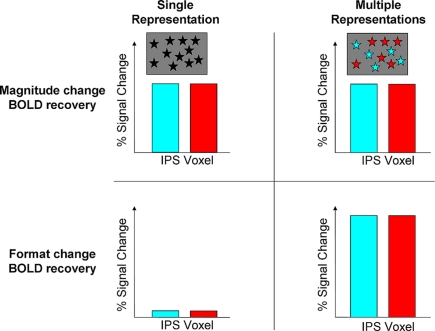Figure 2.
Predictions of the recovery for magnitude and format change by the abstract and multiple representations. In this 2 × 2 matrix, the recovery for magnitude change is predicted to be similar for both hypotheses. This can be due to a single abstract representation in an IPS voxel (black asterisks), or because of multiple but overlapped representations due to developmental principles of human brain organization [turquoise (digits) and red (dots) asterisks]. Both hypotheses differ in the predictions for BOLD signal recovery during format change. The single representation predicts that although the format has been changed no recovery will be obtained as the same quantity is being presented. In contrast, the multiple representations hypothesis posits that during format change a full recovery will be obtained in the same areas that showed recovery for magnitude change. This recovery should be comparable or even stronger, but not weaker, compared to magnitude change, as a new representation comes into play (e.g., separate neuronal substrates for dots and digits, e.g., for 6 dots vs. the digit 6). In contrast, compared to format change, the recovery for magnitude change is only partial as neurons for a given quantity also code other similar magnitudes to some degree (Nieder and Miller, 2003; Cohen Kadosh et al., 2010).

